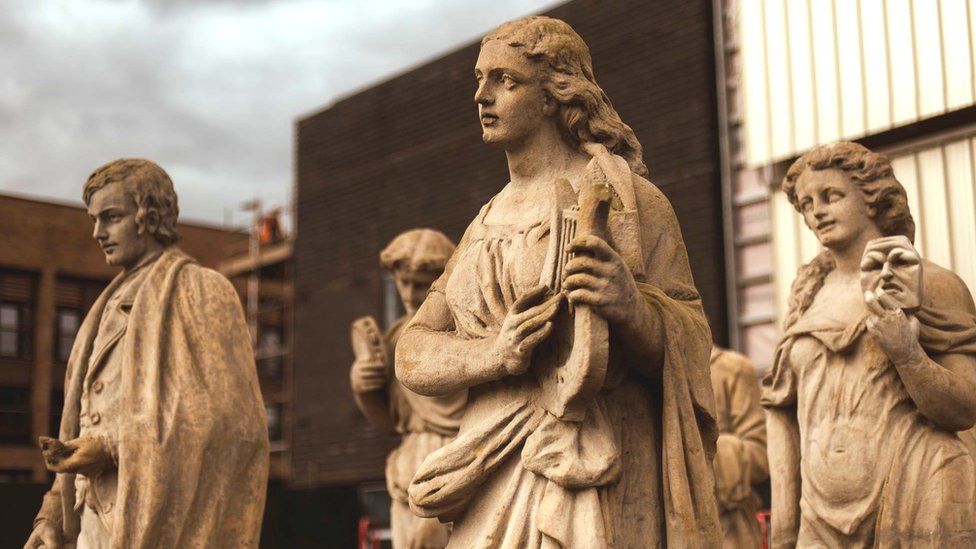Citizens Theatre statues returned to rooftop
- Published

For more than 100 years they were a fixture of Glasgow's skyline, watching over theatre-lovers visiting one of the city's most popular arts venues.
Yet the six statues which once stood on top of the Gorbals' Citizens Theatre have been in its foyer since 1989.
But now, after a lengthy and painstaking restoration, they have returned to the building's roof.
It is part of a wider redevelopment of the theatre, which is due to reopen next year.
The statues date back to when the building first opened in 1878.
They represent the four Greek muses - Melpomene (tragedy), Thalia (comedy), Euterpe (song and poetry) and Terpsichore (dance) - alongside Shakespeare and Burns.
The statues once stood on the roof of a shared façade between the Citizen and Palace Theatres.
They survived a fire in 1973 but the building in 1977 and the statues were removed and placed into storage.
By the time the statues were brought to the foyer of the Citizens Theatre in 1989, signs of age were already visible and one of the muses - Thalia - was missing the mask she typically holds.
Sculptor David J Mitchell was tasked to restore all six sculptures in his Glasgow studio.
Mr Mitchell spoke to BBC Scotland's The Loop about restoring the statues and how he replaced parts lost to time. He he used an old blurry photo to make a clay model and mould to replace the mask.
The building's redevelopment project designed by architects, Bennetts Associates, is the largest redevelopment of the category B building since it opened.
The work will focus on maintaining the building's Victorian features such as original paint frames and stage machinery and allow the public to access them.
The building work is expected to be completed by summer of 2024, allowing creative work to begin in the autumn.
Alex McGowan, executive director and joint CEO of the Citizens Theatre said: "I'm delighted to see the restored statues return to the roof of the theatre as we mark another significant milestone in our journey to re-opening.
"We also hope it is an exciting moment in the wider regeneration of the Gorbals as we restore and reimagine a visual landmark for our local area. The Citz is an iconic building with a huge history, but its beautiful Victorian features were hidden behind an uninviting yellow brick facade.
"The new frontage to the theatre completely transforms that. Throughout the project, audiences have enthused about the statues that welcomed them to the theatre for decades in our old foyer. Now they are back in their historic position, as they were 145 years ago, ready to welcome people back to the Citz when we re-open our doors next year."
James Nelmes, director of Bennetts Associates said: "It's exciting to see a key part of our design for the redevelopment of the Citizens Theatre come to fruition. The statues on the roof will sit alongside pink neon and black brick encompassing the many old and new traditions that make up the identity of the building.
"The Citz has always married its heritage with a contemporary, international outlook and we have reflected that in our design. The redevelopment will deliver spaces and experiences full of character, reflecting the unique and idiosyncratic nature of the theatre building and company."
- Published21 November 2017
- Published10 June 2014